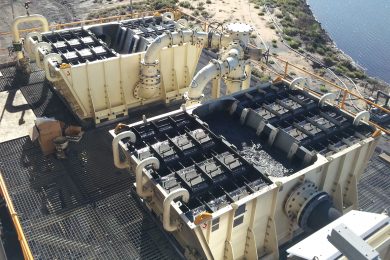Reflux™ Classifier (RC™) technology is rapidly gaining popularity in coal processing applications in Africa because of its ability to easily handle varying feed conditions. Traditional technology cannot accommodate these feed variations resulting in recovery losses whereas the RC is a lot more forgiving of solids feed rate variations. This allows a consistent separation and as a result a higher separation efficiency.
FLSmidth has an installed base of RC technology in coal applications in the Waterberg and in Mozambique. Terence Osborn, Commercial Manager of Minerals sub Saharan Africa at FLSmidth, says that as the coal processing industry has grown in Mozambique, so too has the adoption of FLSmidth’s RC technology by multiple mines in this country.
The first four RC 3000 units sold in this region are the largest in the FLSmidth range and were among the first such units to be sold globally. The commissioning of these was a critical milestone both for FLSmidth and for the mine. Each of these units, now installed and commissioned, is capable of treating approximately 200 t/h of raw fine coal.
Significantly, the success achieved by the RC technology in the second phase of this coal processing plant resulted in the RC being chosen as the technology of choice for retrofit to the original plant. Prior to this, test work was conducted on site by FLSmidth using its mobile test RC 300 rig to validate the expected performance of the larger RC units.
The results from the pilot plant test work proved a business case to replace the existing spiral technology, leading to the sale of four additional RC 3000 units to the mine. These will be commissioned when the extension to the existing plant is completed.
Osborn says the successes achieved with the RC technology is because it offers far greater process flexibility in operation and generally has a higher efficiency which produces higher recovery at similar ash%.
Minimal operator input is necessary because only one operational control is required; the density set-point controlling the cut point. This equipment also offers an indirect environmental benefit, since far less steel is required for the RC equipment and therefore lower carbon emissions are associated with the installation.
The RC incorporates a ‘laminar high shear rate’ mechanism, which represents the latest in fine particle gravity based separation technology. The lamella section enhances the efficiency/capacity of the RC, producing a more compact, higher efficient separation unit when compared to competing fine coal and mineral processing equipment such as spirals, up-current classifiers and teeter bed separators.
FLSmidth offers commercial units from the RC 850 (850 mm diameter, 18 to 20 t/h), up to the RC 3000 (3 m diameter, 200 to 250 t/h), with actual unit capacities related to the feed material and the feed material sizing.
FLSmidth delivers the RC product as a packaged solution, which includes all auxiliary equipment, support steelwork and piping, materials handling equipment and electrical reticulation.
“Based on the added value that can be achieved with this technology, FLSmidth can offer alternative project execution models to give potential customers earlier access to this technology by reducing the upfront capital cost burden. This is in addition to the company’s capability to support ongoing operations and maintenance of these solutions,” Osborn says.
RC solutions are designed for easy transport, assembly and installation, with the standard solution being designed to be assembled in sections based on standard containers sizes.










